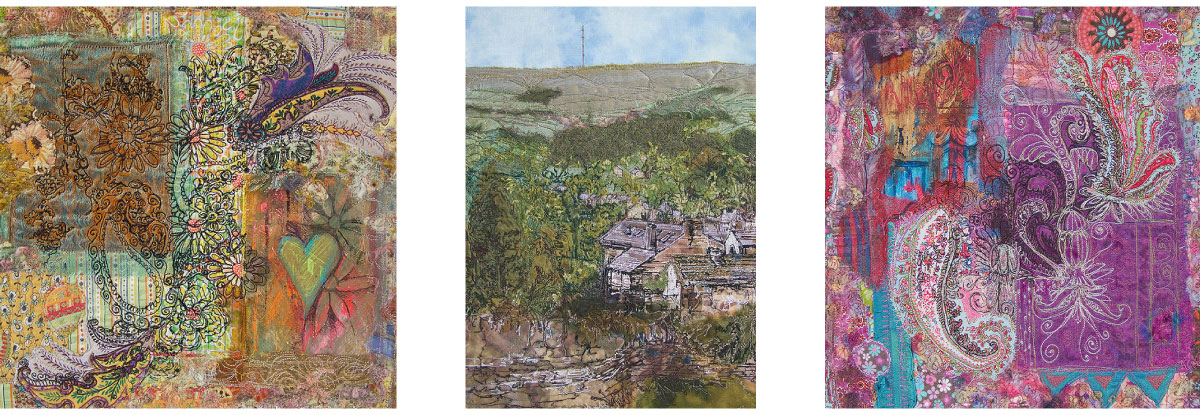Crafts to support neurological occupational therapy and brain injury rehabilitation

Which craft used in occupational therapy has been proven to trigger physiological changes that calm the brain?
Occupational therapists have been using craft activities as tools to facilitate physical, cognitive and social development since the founding of the profession in the early 1900s.(Read more about the history of occupational therapy here.)
Yet, despite qualitative evidence of the benefits as time progressed, the practice was often dismissed by the wider healthcare community or, at worst, mocked.
Even as recently as 2003, leading OT voices were stepping up to defend the use of crafts, not simply as a means to add meaning and value to an individual’s life but to drive and enhance rehabilitation outcomes following illness or injury.
“Crafts were there at the beginning,” Muriel Driver Award winner, Professor Judith Friedland says in her 2003 lecture to the Canadian Association of Occupational Therapists. [1]
“Yet we prefer to dismiss them as an unfortunate part of our past. Indeed, it is as if we are ashamed of these occupations.”
Fast forward to 2021, however, and it’s a shame OTs were ever ashamed of craft therapy – because body scanning technology is now starting to prove them right!
In a recent experiment, Japanese researchers traced electrical activity in the brain using electroencephalography (EEG) and in the heart using ECG (electrocardiography) while participants carried out a craft task for 7 minutes.
Comparing the readings to those taken while at rest, they found that participants achieved a state of relaxed concentration as they crafted. [2]
But what was that craft?
The answer follows - along with 11 other craft activities that have earned evidential (if not yet scientific) credibility in their use during neurorehabilitation:
Needlework
In the Japanese study, the participants made a bookmark, employing what the researchers refer to as ‘a form of canvas craft’. It involved threading metallic yarn through a soft polyethene mesh of 3mm holes with a special needle. (It’s likely called needlepoint in the UK.)
But, of course, there are other types of yarn-based crafts creating avenues for neuro OT intervention.
Pearls of insight gathered by occupational therapy researchers in Canada demonstrate how knitting improves the mood, presents cognitive and creative challenges and facilitates skill development. [3]
While weaving textiles with embroidery altered the pattern of life forever for brain injury survivor, Sally Wilson who went on the win national accolades for her exquisite creations. [4]
 Textile art has definitely been a saviour and a fantastic form of rehabilitation/therapy.
Textile art has definitely been a saviour and a fantastic form of rehabilitation/therapy. 
Artist and brain injury survivor, Sally Wilson.
Some examples of the stunning textile artwork created by Sally Wilson are here. You can see the whole collection and read about Sally's journey by visiting the link at the end of this article.

Beading
It’s a valued cultural craft activity that dates back over 3,400 years in Ghana, West Africa, but in the last decade, beading has become an important part of the country’s occupational therapy practice too.
The therapeutic use of beading has been observed to help with attention, organisational skills, pattern recognition, hand function and bilateral coordination, according to new research by University of Ghana OT students. [6]
Clay modelling
When Scottish-born OT, Alice McCall Smith was diagnosed with multiple sclerosis 3 years after the birth of her second child, she was suffering from “deep” depression.
 I went from a glass is full person (and it’s fizzy), to where is the glass? I lost my drive and creativity. I desperately wanted to sleep.
I went from a glass is full person (and it’s fizzy), to where is the glass? I lost my drive and creativity. I desperately wanted to sleep. 
Five years later, inspired by the fun her daughters were having at recreational clubs, Alice joined a community-based sculpting class – and discovered ‘the joy of clay’.
Now working as an artist in North Carolina, Alice educates occupational therapy students on the therapeutic use of clay and the benefits of incorporating art into OT practice. [5]
Art
Art lies at the heart of a project to help brain injury survivors at the branch of East London Headway – the brain injury association.
But the emerging talent of one member turned heads when the Hackney-based art studio hosted its first exhibition at Stratford Circus. [7]
Brian Searle became homeless after a brain injury at the age of 16 but went on to gain a degree in Fine Art despite cognitive impairments arising from his injury and dyslexia.
 [Art has] made me a better person, given me more confidence and made me achieve more.
[Art has] made me a better person, given me more confidence and made me achieve more. 
Producing art from the charity’s studio has now become Brian’s profession, but he also enjoys teaching others and has shared his inspiring story via the charity’s website. [8]
Cooking
It’s an essential activity of daily living and one that is regularly employed by occupational therapists to facilitate functional independence following brain injury.
And yet, startlingly, the scientific jury is out as to whether cooking is an effective rehabilitative intervention, according to a new systematic review of relevant research published by the British Journal of Occupational Therapy. [9]
The problem lies in the lack of standardised studies globally - a recurring theme when it comes to pinning down the neuroscience behind glaringly successful OT outcomes.
So while we wait for the data, let’s turn to observational evidence such as the incredible progress of Krysalis client, Chris who, just 7 years ago, was in a coma with a severe brain injury having fallen from a tree.
 If [Chris’s] recipe collection is anything to go by, his neurorehabilitation is working as a heavy-duty food mixer at top speed – combining all the right ingredients.
If [Chris’s] recipe collection is anything to go by, his neurorehabilitation is working as a heavy-duty food mixer at top speed – combining all the right ingredients. 
Chris’s love of cooking and determination to relearn cooking skills have proven pivotal during his recovery and continue to drive his rehabilitation goals.

The former tree surgeon is now walking and talking again and regularly cooks for himself, his family and support team in his own kitchen. He’s also learned no less than 27 recipes in that time - proof in the OT pudding, surely! More on Chris' journey through brain injury rehabilitation here: Chris and Denise a unique journey.
Gardening
Motor, sensory-motor, and cognitive functions are ‘significantly improved’ by nature-based rehabilitation and it enhances the quality of life, according to a 2019 scoping review of the benefits. [10]
UK charity, Thrive has been acting on that understanding for over 40 years, using an approach called social and therapeutic horticulture.
Linking people with plants, Thrive’s trained therapists use gardening to improve physical and psychological health and cognitive skills to bring about ‘profound positive changes’. [11]
Photography/writing/poetry
Photographs, poems and stories presented by or about brain injury survivors have been shown to help communicate their lived experience and, in doing so, change perceptions and care approaches in neurorehabilitation. [12]
Headway – the brain injury association acknowledges that, for brain injury survivors and their loved ones, a photo can be ‘a reminder of lost memories’ or a symbol of their progress. [13]
 Even now, all the way through writing this, I can hear my thinking voice saying to me, ‘Keep focused Annie, break it down Annie, don’t drift off Annie, what is my goal’?
Even now, all the way through writing this, I can hear my thinking voice saying to me, ‘Keep focused Annie, break it down Annie, don’t drift off Annie, what is my goal’? 
Our own Krysalis blogger, Anne Ricketts is one of many brain injury survivors who share their experiences through the written word to try to help others recover – and attribute improvements in their own neurorehabilitation to the craft of writing. [14]
While celebrated Aberdeen poet, Sid Ozalid performed live poetry internationally as a means to “treat” a severe brain injury in 2017 that left him with memory loss and unable to walk or talk. [15]
Related articles
200 Home activities for brain injury survivors and their families
Waltz with us on world stroke day
How to enjoy a daily dose of exercise despite brain injury
Over 30 online communities to help keep spirits high among brain injury survivors and their families during the covid19 lockdown
Twenty apps to boost brain injury rehabilitation
References
1. J. Friedland, “Why crafts? Influences on the development of occupational therapy in Canada from 1890 to 1930,” Canadian Association of Occupational Therapists, 2003.
2. Shiraiwa, K. et al, “Changes in Electroencephalography and Cardiac Autonomic Function During Craft Activities: Experimental Evidence for the Effectiveness of Occupational Therapy,” Frontiers in Human Neuroscience, December 2020.
3. Brooks, L. et al, ““I just love it”: Avid knitters describe health and well-being through occupation,” Canadian Journal of Occupational Therapy, March 2019.
4. https://www.sallywilson.co.uk/
5. J. Fortuna, “Promoting Healing with Therapeutic Use of Clay,” The Open Journal of Occupational Therapy, 2019.
6. Ndaa, P. O. et al, “Beading as a therapeutic activity in Ghana,” World Federation of Occupational Therapists Bulletin, 2021.
7. “Brain injury survivors show their artistic sides with the first public exhibition at Stratford Circus,” Hackney Citizen, 10 January 2017.
9. Mohapatra, S. et al, “Kitchen-related tasks used in occupational therapy during the rehabilitation of adults with acquired brain injury: A systematic review,” British Journal of Occupational Therapy, September 2020.
10. Vibholm, A. P. “Nature-based rehabilitation for adults with acquired brain injury: a scoping review,” International Journal of Environmental Health Research, 2020.
11. https://www.thrive.org.uk/
12. https://www.krysalisconsultancy.co.uk/resources/item/humanising
14. https://www.johnbyrneaward.org.uk/entries/can-poetry-help-cure-traumatic-brain-injury/
